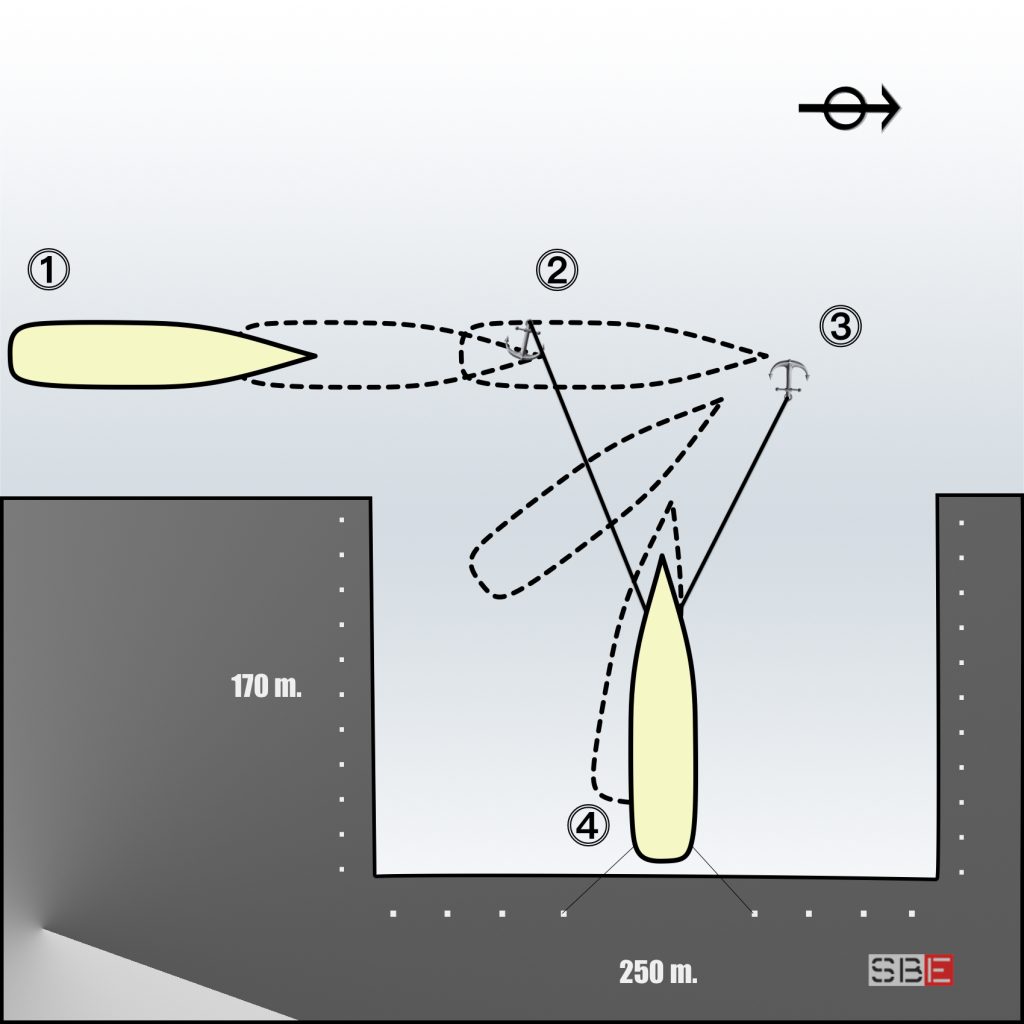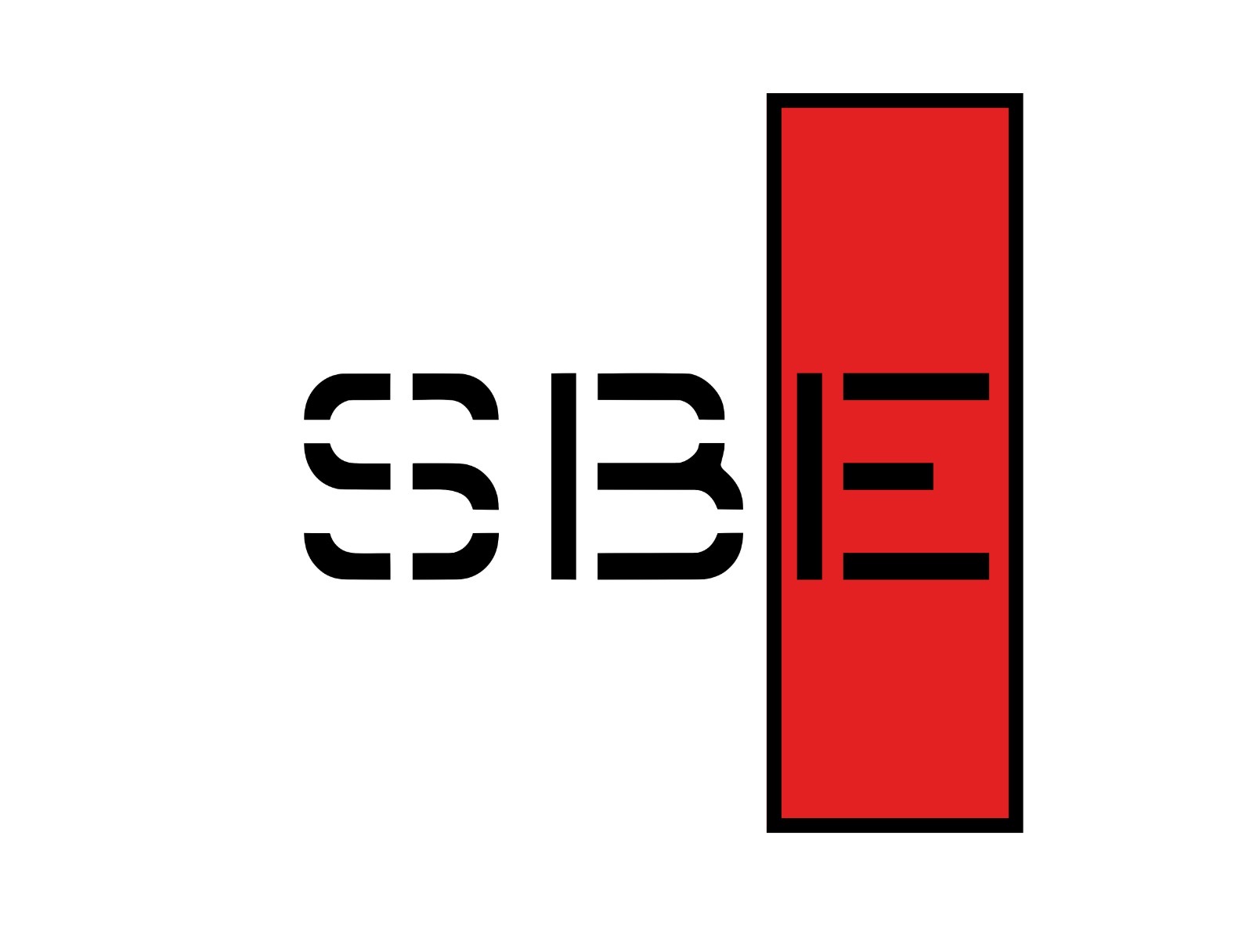Mooring Stern on the Quay with Wind and Current Copy
Let’s start immediately with a practical example that will confront the need for a strategic analysis of the manoeuvre:
- Ro-Ro – 130 meters long.
- Six meters draft at the stern and five at the bow.
- Single-propeller left-handed variable pitch with right-handed effect.
- 600 horsepower bow thruster;
- Weather forecast: calm.
We briefly describe the manoeuvre, which, in this situation, is quite simple to plan. We leave out the first part as it has already been extensively treated.

The choice of the anchor set points is simplified by the knowledge of the ship’s measurements – bow and stern distances from the bridge – and the presence of the two docks that include the ‘ferry slip’ where we will lower the aft ramp of the Ro-Ro.
In our case, knowing that:
- The head of the quay is 170 meters long,
- The bollards are 15 meters apart,
- From the stern to the bridge, there are 35 meters,
- From the bridge to the bow, there are 95 meters,
- The distance between the mooring quay and the pier-head is 250 meters,
- The stop will be 10 hours, and the weather conditions are fair;
We decided that four chain shackles per side would be enough for safe mooring, and from the drawing above, we can see how to obtain the setpoints to drop our anchors.
We adjust the engine appropriately to ‘let go’ the port anchor with about 2 knots of speed. As soon as we have room for turning clear, we drop the starboard anchor with a residual velocity of less than 1 knot. We hold on to the port anchor and run the engine Half-Astern and the bow thruster to port.
The effects of the port cable, the propeller, and the bow thruster make the ship rotate decisively counterclockwise, and soon, feeling the engine power, she begins to proceed astern. Finally, we stop the thruster and slow down the engine, holding the port anchor and slackening the starboard until settled.
We slack both chains by controlling the ship’s direction with the bow thruster. When close enough to the mooring position, the hull slightly shifted to the port side to compensate for the paddle-wheel effect. First, we send the port stern line to the mooring boat (this also helps us counteract the stern’s tendency to starboard). Then, we send the starboard one.
About fifteen meters from the position, we hold on to the two chains and stretch them by heaving on the lines and keeping the engine astern. Once the chains are in force, we put them on gear slacking link by link to the final position.
Now, let’s see the same manoeuvre with a SE wind of 20 knots and an E current of 1 knot.
If the propeller effect had been right-handed, we could have tried to keep the stern always in the wind by manoeuvring with skill and, once we completed the turning, we could count on the shelter of the quay— this is a ‘delicate but possible’ manoeuvre.
In our case, the left-handed effect of the propeller adds to the wind and the current, making it very difficult to control the stern. For this reason, to guarantee a certain level of safety, we decide to use a tugboat.
Unlike the previous example, given wind and current, we decide to drop seven shackles to port and five to starboard. The vessel stop is not long, and the possibility of changing the weather and sea conditions is scarce. Even if the wind changed direction, the current would remain unchanged. Therefore, it is preferable to have two more shackles on the port because, at the end of turning to starboard, we will have more chains to hold us in the direction of the current and the wind, limiting the risk of drifting. In addition, we will indeed be able to use the engine and possibly the tugboat to keep the stern. Still, if the starboard obstruction were too close, we would not have the space to turn the stern to direct the bow in the wind. The bow would be exposed laterally, risking falling towards the dock not under control (the bow thruster would not have sufficient power to support the situation and having little chain can only make the situation worse).
How will we position the vessel at anchor set points?
In a situation like this, we must not give absolute importance to the logic of turning regarding the paddle-wheel effect. Other more decisive elements occur during the manoeuvre: the tugboat, the wind, and the current. Features and forces that must be supported rather than opposed.
So, assuming that we could replicate the last manoeuvre by adding the help of the tug, we believe the one we are going to explain is better:
INSERIRE VIDEO
We make fast the tugboat on the port side at the point closest to stern-quarter. The reasons are two:
- It will always work in the wind, free from the propeller’s slipstream.
- It will continue working until the end without hindering the mooring boat and the descent of the ramp.
We stop the engine before the intended setpoint to drop the port anchor, proceeding with only the residual headway. We run the engine ‘Half Astern’ and take advantage of the propeller’s effect and the bow thruster acting on the port, and we turn until we have the bow into the wind.
The rotation will take place without problems. The bow thruster will act as a pivot to the thrust of the wind and the current. Once the turning is complete, we proceed backwards, steering with the bow thruster and the tug. Keeping the head to the wind and the current allows us to control the ship.
We reach the set point of the port anchor with a minimum sternway. Now the tug is starting to pull us slowly towards the mooring position. We say slowly because, in reality, the entire first part of the manoeuvre is done by exploiting the wind and the current and not opposing them.
While the stern enters the basin, we slack the chain making the bow fall towards the point, further back, where we want to drop the starboard anchor. After positioning the two anchors, we hold the port chain; we move backwards using the engine – while the tugboat keeps our stern up in the wind – until the two chains are settled.
When we are close enough to the final mooring position, since the stern is free from the tug’s wake, we pass the lines to the mooring boat and proceed as in the previous example.
